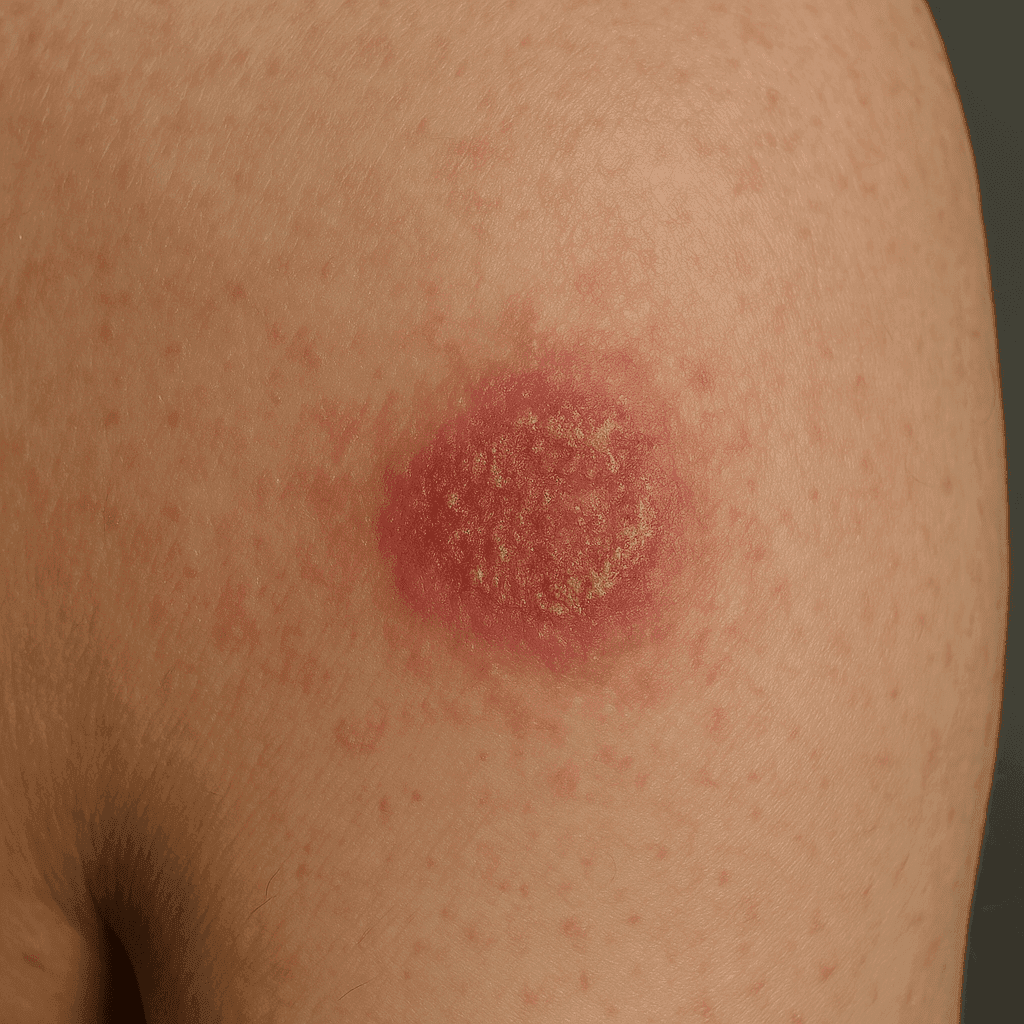Eczema Nummularis
What is eczema nummularis?
Frothy eczema, also known as eczema nummularis, is a chronic skin condition characterised by round, itchy patches. These skin lesions can resemble coins, hence their name. This eczema is often confused with other skin conditions such as atopic dermatitis or psoriasis.
What does frothy eczema look like?
The skin lesions are usually well-demarcated, red or brownish, and may be covered with scales. They can appear on different parts of the body, but are most common on the extremities. Itching is one of the main symptoms, often leading to scratching, which can worsen the skin condition.
Symptoms of foamy eczema
Symptoms of frothy eczema can vary from person to person, but most commonly include itching, redness and dry skin. In adults, these changes can be more pronounced and persistent, often leading to discomfort in daily life.
Typical symptoms in children
In children, frothy eczema may take a milder form, but should not be underestimated. Skin lesions in children may be less extensive, but the itching can lead to sleepless nights and irritability. It is important to adequately moisturise your child's skin and avoid irritants.
Causes and risk factors
Although the exact causes of frothy eczema are not fully understood, there are several factors that may increase the risk of this condition.
Genetic factors
As with many skin diseases, genetics play a significant role. People with a family history of atopic dermatitis, asthma or allergies are more likely to develop foamy eczema.
Impact of the environment and allergies
Environmental factors such as cold weather, low humidity and contact with irritating chemicals can exacerbate symptoms. Allergies to food, pollen or animal dander can also influence the development and severity of the disease.
The role of stress in disease development
Stress is an often underestimated factor affecting skin health. In the case of frothy eczema, stress can exacerbate symptoms and cause relapses. Stress management techniques, such as meditation or yoga, can be helpful in managing symptoms.
Diagnosing foamy eczema
Diagnosis of foamy eczema is based on a thorough clinical assessment. Dermatologists usually diagnose the disease based on its characteristic symptoms, but in some cases additional skin tests may be necessary.
Diagnostic methods
Allergy tests, skin biopsies and assessment of the patient's history can help differentiate foamy eczema from other skin conditions.
Treatment of foamy eczema
The treatment of foamy eczema includes both pharmacotherapy and topical therapies. The aim of treatment is to relieve symptoms and prevent recurrence.
Pharmacotherapy
Corticosteroids are often used to reduce inflammation. Antihistamines can be used to relieve itching, which helps prevent scratching and worsening of the skin condition.
Topical therapies
The use of moisturising creams and ointments is key to keeping the skin hydrated. Medicated baths with oils or salves can also provide symptom relief.
Home and natural treatments
Some people choose to use herbs and supplements to aid treatment. Calendula, aloe vera or tea tree oil extracts are popular. Dietary changes, such as avoiding allergenic foods, can also help control symptoms.
Eczema and lifestyle
Lifestyle has a significant impact on the course of the disease.
Importance of diet
A diet rich in antioxidants, omega-3 fatty acids and vitamins can support skin health.
Avoidance of irritants
Avoiding contact with irritants and tobacco smoke is key to preventing recurrence.
Stress management techniques
Regular exercise, meditation and other relaxation techniques can help reduce stress, which is often an exacerbating factor for symptoms.
Prevention of frothy eczema
Preventing the recurrence of foamy eczema requires regularity and diligence in skin care.
How to prevent recurrences?
Regular use of moisturisers and avoidance of irritants is key. It is also advisable to maintain good hygiene and avoid prolonged contact with hot water.
Eczema and other skin diseases
Comparison with atopic dermatitis
Foam eczema and atopic dermatitis share many symptoms, but differ in the course and location of the lesions. Atopic dermatitis is more related to genetics and often occurs from early childhood.
When to consult a doctor?
It is a good idea to consult a doctor if the symptoms of frothy eczema do not disappear despite the use of home remedies. Preparation for the visit includes gathering information about the medication used and observations about the skin condition.
Summary
Frothy eczema is a chronic skin condition that can affect quality of life. Early recognition and appropriate treatment are key to minimise discomfort and prevent recurrence. Systematic care, avoidance of irritants and a healthy lifestyle can significantly improve symptom control.
Frequently asked questions
FAQs about eczema foley
Is frothy eczema contagious?
No, foamy eczema is not a contagious disease.
What are the most common triggers of symptoms?
Triggers include stress, allergens and weather changes.

